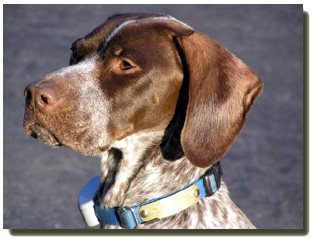
Braque Francais
Group: Sporting Group
Origin: France
Varieties: Gascogne and Pyrénées
Height:
- – Pyrénées: Males: 47 to 58cm
– Gascogne: Males: 58 to 69cm
– Females of both types are slightly smaller
Also Known As: French Pointer; French Pointing Dog – Gascogne Type and Pyrenean Type
CLICK HERE to View Breeder Listings
Breed Profile
The literal translation for the Braque Français is the French Pointer or French Pointing Dog. There are two types of Braque Français — the Gascogne and the Pyrénées. The more common of the two is the Pyrénées. The breed is much more popular in France and other parts of Europe than in North America and the United Kingdom where it is still rarely seen. It is, however, starting to gain popularity among sportsmen, especially in Quebec.
The Pyrénées is a smaller dog than the Gascogne. Both breeds date back to the 1600’s and are said to pre-date the modern short-haired hunting breeds. The Braque is known for his soft mouth and is a natural in the field and in the home. He is very intelligent, sensitive and affectionate. In the home he is very gentle with children and makes an ideal pet. He is an excellent tracker and hunting dog, a good retriever and a hard worker.
Health Issues
If you are considering the adoption of a Braque Français puppy, or any breed, it is very important to be selective in choosing a responsible and reputable breeder. Ensure that the prospective puppy’s parents have all health clearances. Breeding of any dog should not be done until after they have been proven to be free of evidence of significant hereditary diseases. (For more information on selecting a breeder, see the articles on the General Information page.)
Additional Health Resources:
- Canine Health Information Center (CHIC) — Providing a source of health information for owners, breeders, and scientists that will assist in breeding healthy dogs. CHIC is a centralized canine health database jointly sponsored by the AKC/Canine Health Foundation (AKC/CHF) and the Orthopedic Foundation for Animals (OFA).
- Health and Nutrition — Growing section of the Canada’s Guide to Dogs website which includes information on several health and nutrition related issues.
- AKC Canine Health Foundation — Working towards developing scientific advances in canine health.
- OFA – Companion Animal Eye Registry (CAER)
- Orthopedic Foundation for Animals (OFA)
- Ontario Veterinary College (OVC)
- University of Pennsylvania Hip Improvement Program (PennHip)
- HealthGene — HealthGene Corporation is the leading provider of veterinary DNA diagnostic services in Canada.
- Labgenvet — Laboratory of Veterinary Genetics is a Canadian diagnostic laboratory that offers a comprehensive service of DNA tests for veterinary genetic diseases.
Breed Standards
- CKC Breed Standard – Braque Français Gascogne
- CKC Breed Standard – Braque Français Pyrenees
- UKC Breed Standard – Braque Français de Grande Taille
- UKC Breed Standard – Braque Français de Petite Taille
- FCI Breed Standard No. 133 — Braque Français type Gascogne (French Pointing Dog – Gascogne Type)
- FCI Breed Standard No. 134 — Braque Français type Pyrénées (French Pointing Dog – Pyrenean Type)

Mia du CBFQ (Mia)
Photo: Jersey Sporting Dogs
Grooming Information
- Grooming — This section of the Canada’s Guide to Dogs website includes tips, articles and information covering all aspects of dog grooming along with a listing of Groomers from across Canada.
Training Resources
- Training — For training information, see this growing section of the Canada’s Guide to Dogs website for tips, articles, as well as listings of training centres across Canada.
Additional Information
- Clubs, Sports & Activities — For information on the many sports and activities you can get involved in with your dog.
- Working Dogs — The Working Dogs section of the Canada’s Guide to Dogs website provides information and listings of organizations that are involved in various dog jobs, such as Guide Dogs, Therapy Dogs, Police Dogs, Protection Dogs, and much more.
*NOTE 1: CHIC – The Canine Health Information Center “is a database of consolidated health screening results from multiple sources. Co-sponsored by the Orthopedic Foundation for Animals (OFA) and the American Kennel Club (AKC) Canine Health Foundation, CHIC works with parent clubs to identify health screening protocols appropriate for individual breeds. Dogs tested in accordance with the parent club established requirements, that have their results registered and made available in the public domain are issued CHIC numbers.” To learn more, visit: www.caninehealthinfo.org
*NOTE 2: The Fédération Cynologique International (FCI) is the World Canine Organization, which includes 91 members and contract partners (one member per country) that each issue their own pedigrees and train their own judges. The FCI recognizes 344 breeds, with each being the “property” of a specific country. The “owner” countries write the standards of these breeds in co-operation with the Standards and Scientific Commissions of the FCI, and the translation and updating are carried out by the FCI. The FCI is not a breed registry nor does it issue pedigrees.
Breed Listing
Quick Links
Get In Touch
- Email: canadasguidetodogs@gmail.com
- Email: info@canadasguidetodogs.com
- Visit us on Facebook: www.facebook.com/CanadasGuideToDogs
— CanadasGuideToDogs.com is an Amazon Associate as well as a participant in various affiliate programs, as such fees are earned from qualifying purchases.

